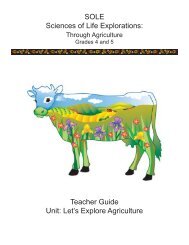Verticillium Wilt of Tomato - New York State Integrated Pest ...
Verticillium Wilt of Tomato - New York State Integrated Pest ...
Verticillium Wilt of Tomato - New York State Integrated Pest ...
You also want an ePaper? Increase the reach of your titles
YUMPU automatically turns print PDFs into web optimized ePapers that Google loves.
DISEASES OF TOMATOES<br />
<strong>Verticillium</strong> <strong>Wilt</strong><br />
COOPERATIVE EXTENSION. NEW YORK STATE. CORNELL UNIVERSITY<br />
Page: 735.20<br />
Date: 8-1980<br />
<strong>Verticillium</strong> <strong>Wilt</strong> <strong>of</strong><br />
<strong>Tomato</strong><br />
by Arden Sherf<br />
Dept. <strong>of</strong> Plant Pathology<br />
Cornell University<br />
<strong>Verticillium</strong><br />
wilt <strong>of</strong> tomato<br />
The soilborne fungus Verlicillium<br />
albo-alrum is present in most cool<br />
soils <strong>of</strong> the Northeast and can attack<br />
over 200 plant species, especially<br />
tomatoes, potatoes, eggplant,<br />
strawberries, and black raspberries.<br />
Other susceptible vegetables include<br />
artichoke, beet, broad bean, chicory,<br />
cucumber, dandelion, endive,<br />
horseradish, musk mellon, okra,<br />
peppers, radish, rhubarb, salsify, and<br />
watermelon. Corn, other cereals, and<br />
grasses are resistant.<br />
Symptoms<br />
In spite <strong>of</strong> the name verticillium<br />
wilt, a true wilt seldom occurs in<br />
tomato, at least not until late in the<br />
season. Rather, under good conditions<br />
<strong>of</strong> moisture and nutrition, yellow<br />
blotches on the lower leaves may be<br />
the first symptoms, then brown veins<br />
appear, and finally chocolate brown<br />
dead spots. The spots may be<br />
confused with alternaria early blight,<br />
but they are not definite, nor do they<br />
develop concentric bull's-eye rings.<br />
The leaves may wilt, die, and drop<br />
<strong>of</strong>f. The disease symptoms progress<br />
up the stem, and the plant becomes<br />
stunted. Only the top leaves stay<br />
green. Fruits remain small, develop<br />
yellow shoulders, and may sunburn<br />
beca use <strong>of</strong> loss <strong>of</strong> leaves.<br />
Infection takes place directly when<br />
the fungus threads enter the root<br />
hairs. It is aided in its entrance if<br />
rootlets are broken or nematodes have<br />
fed on the root system. The fungus<br />
grows rapidly up the xylem, or sapconducting<br />
channels. Its activity there<br />
results in interference with the normal<br />
upward movement <strong>of</strong> water and<br />
nutrients. The fungus produces a<br />
toxin that contributes to the wilting<br />
and spotting <strong>of</strong> the leaves. Diagnosis<br />
involves making a vertical slice <strong>of</strong> the<br />
main stem just above the soil line and<br />
observing a brown color in the<br />
conducting tissues under the bark.<br />
This discoloration can be traced<br />
upwards as well as downwards into<br />
the roots. In contrast to fusarium wilt,<br />
verticillium wilt discoloration seldom<br />
extends more than 10-12 inches above<br />
the soil, even though its toxins may<br />
progress farther.<br />
The Causal Fungus<br />
Its wide host range permits<br />
Verlicillium to persist in soils for long<br />
periods. It remains alive by means <strong>of</strong><br />
dark resting threads, which form in<br />
great numbers on dying diseased<br />
underground plant parts. It can attack<br />
and mUltiply in many common weeds,<br />
including ragweed, cocklebur, and<br />
velvet leaf. One form <strong>of</strong> the fungus<br />
produces tiny black resting bodies<br />
(microsclerotia), which help it survive<br />
over winter.<br />
The pathogen is sensitive to soil<br />
moisture and temperature. <strong>Tomato</strong>es<br />
and potatoes must have at least a day<br />
<strong>of</strong> saturated soil before infection<br />
occurs. Soil temperatures must be<br />
modera te or cool for infection to take<br />
place: 75° F (24° C) is optimum with<br />
55° F(13° C)minimumand86° F<br />
(30° C) maximum.
Controls<br />
Long rotations (4-5 years) with<br />
nonrelated crops, well-drained soils,<br />
and soil moisture kept at the<br />
minimum for good growth are<br />
advisable.<br />
In greenhouses or with plastic-strip<br />
mulch, soil fumigation gives good<br />
control and is feasible on high-value<br />
crops.<br />
By far the most feasible and<br />
economic control is the use <strong>of</strong><br />
<strong>Verticillium</strong>-tolerant tomato cultivars<br />
<strong>of</strong> which there are many with varying<br />
maturities and excellent horticultural<br />
qualities. These include the following:<br />
<strong>New</strong> <strong>York</strong>er (V)<br />
Springset<br />
Pic Red<br />
Jet Star<br />
Supersonic<br />
Heinz 1350<br />
Heinz 1439<br />
Westover<br />
Royal Flush<br />
Flora merica<br />
Veebrite<br />
Veemore<br />
Veegan<br />
Veeset<br />
Burpee VF Hyb.<br />
Starshot<br />
Earlirouge<br />
Supersteak<br />
Campbell 1327<br />
Fireball (V)<br />
Beefmaster<br />
Better Boy<br />
Bonus<br />
Gardener (V)<br />
Monte. Carlo<br />
Nova (Paste)<br />
Crimson Vee (Paste)<br />
Veeroma (Paste)<br />
Vee pick (Paste)<br />
Ramapo<br />
Moreton Hyb.<br />
Spring Giant<br />
Basket Vee<br />
Campbell 17<br />
Big Set<br />
Setmore<br />
Small Fry<br />
Terrific<br />
Big Girl<br />
Mainpak<br />
Early Cascade<br />
Jumbo<br />
Wonder Boy<br />
Rutgers 39<br />
Ultra Boy<br />
Ultra Girl<br />
Rushmore<br />
J etfire<br />
Would you like our free<br />
catalog <strong>of</strong> extension<br />
publications? Send to:<br />
Distribution Center<br />
7 Research Park<br />
Cornell University<br />
Ithaca, N.Y. 14850<br />
Price per copy 10 cents.<br />
Quantity discount available.<br />
Cooperative Extension, the <strong>New</strong> <strong>York</strong> <strong>State</strong> College <strong>of</strong> Human Ecology, and the <strong>New</strong> <strong>York</strong><br />
<strong>State</strong> College <strong>of</strong> Agriculture and Life Sciences, at Cornell University, Ithaca, N.Y., and the U.S.<br />
Department <strong>of</strong> Agriculture, cooperating. In furtherance <strong>of</strong> Acts <strong>of</strong> Congress May 8, June 30,<br />
1914, and providing equal opportunities in employment and programs.<br />
Lucinda A. Noble, Director. 8/80 CP 3M 6989-A
















